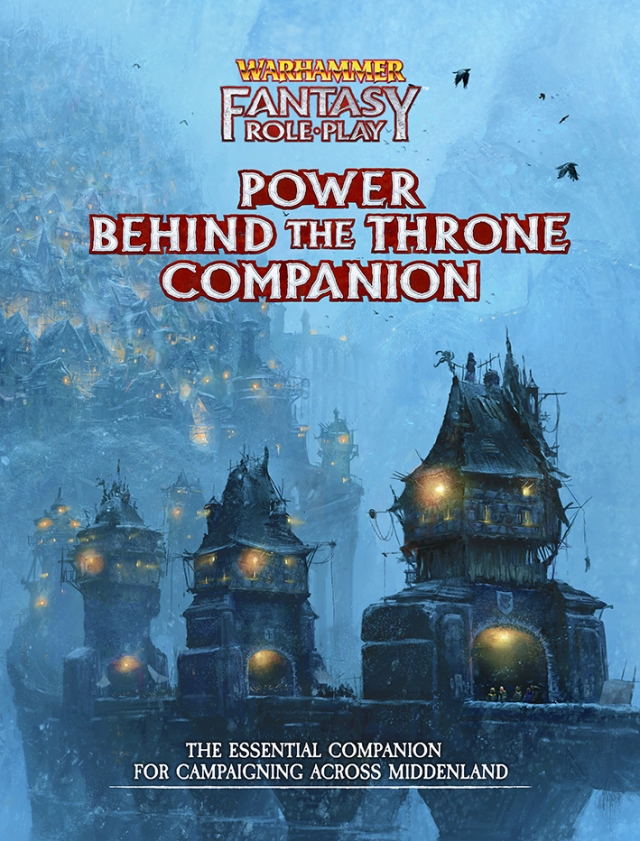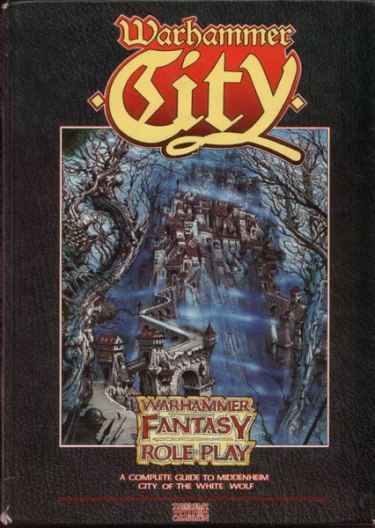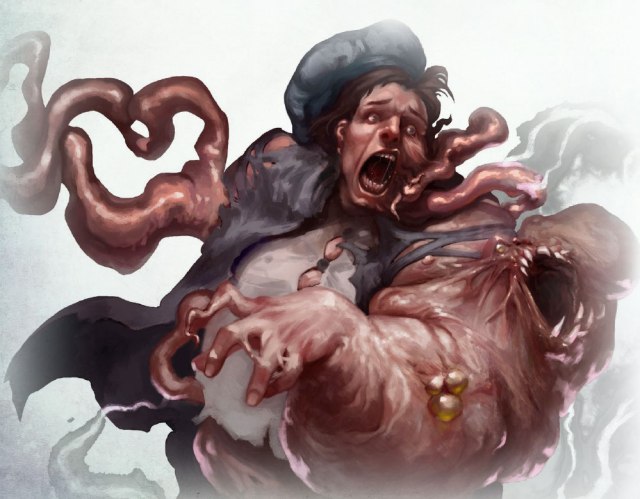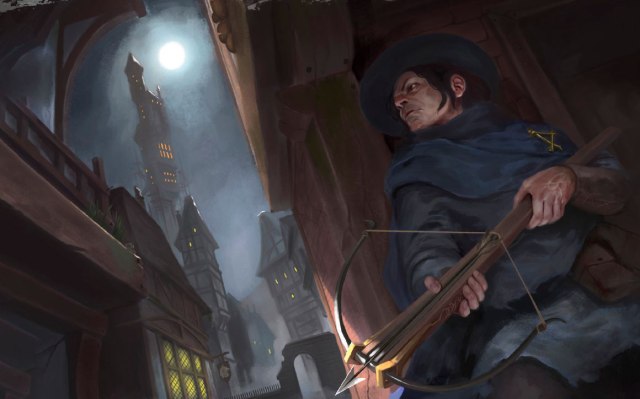
Hopefully better late than never: my review/recap of the Companion volume to the 4E version of Power Behind the Throne.
Background
The Enemy Within: Power Behind the Throne Companion, compiled by Graeme Davis with contributions by Dave Allen, Jim Bambra, Paul Cockburn, Phil Gallagher, Andy Law, Sean Masterson, Pádraig Murphy, Derrick Norton, Anthony Ragan, Carl Sargent, Philip Wells and Simon Wiseman, is the “extra materials” volume for the third part of Cubicle 7’s new “Director’s Cut” reissue of the classic Warhammer Fantasy Roleplay campaign The Enemy Within.
For more of the background and where I’m coming from in reviewing the books, see my review of Enemy in Shadows and the further links there.
See also Gideon’s in-depth review of this book: Power Boost.
General impressions

As I mention in my review, after the major disappointment of the 4E Death on the Reik I was relieved to find Power Behind the Throne had got a decidedly more solid new edition. This made me cautiously hopeful that its Companion book would also be a step up from the previous volume.
As we’ve come to expect from C7, it’s a beautiful book (well, PDF) with plenty of mostly high-quality art. Somme of the art is recycled but quite a bit of it seems to be new. Jonathan O’Donogue’s cover art doesn’t exactly replicate Ian Miller’s cover of the 1E Middenheim book, but clearly references it.
The book contains work by a great number of writers – 13 all in all, as compared to 5 for the Death on the Reik Companion. Of course, much of this will be old stuff recycled from 1E material. Unfortunately, there’s no indication who wrote what, nor are any illustrations individually credited.
Contents
The latest update of the PDF has corrected the earlier, completely misleading cover tagline “The essential companion to campaigning across Middenland” – there’s not a line about this in the book – with the only slightly misleading “The essential companion to campaigning in Middenheim”. In fact this book has a stronger focus than the previous two Companions on material directly relevant to its main adventure. Let’s have a run-through of the chapters.
The (puzzling) preface
As with the predecessors, the book kicks off with a pair of brief retrospective forewords by old hands. This time around, though, they have gone from “brief” to “almost nonexistent”. First we get a few lines of commentary from Derrick Norton, who edited and heavily reworked the original PBtT, and then an equally short tribute to Carl Sargent from Graeme Davis. Both of these pieces say almost nothing.
I was a little baffled by these entries – not by their being there, but by their being so brief and perfunctory I wonder why they bothered to put them in at all. They might at least have provided a link to Norton’s much fuller commentary on Power Behind the Throne on the Awesome Lies blog.
Speaking of Awesome Lies, in a comment on Gideon’s review Derrick Norton shed a little – but only a little – light on this:
“As to my small contribution, the original brief from Cubicle 7 was for 600 words. I submitted 598 but, after a long delay, a hidden power had it edited more-or-less to the version published. I was given to understand there had been staff changes at GW and an increased sensitivity to how the past was mentioned. I had the option of pulling the piece entirely but I did not feel it necessary as I had already commented in detail on your blog.”
This means more than 2/3 of Norton’s piece was cut. I’m not sure exactly what Norton means by “an increased sensitivity to how the past was mentioned”, but taken together with these and later Companions it does look like the writers’ reins to play loose with canon and talk openly about contradictions between editions have been tightened. Which is, obviously, a shame.
Oh well. Onward.

The Graf’s garden party
The first proper chapter is also among the longest and densest at 14 pages. This is a much more detailed, almost Three Feathers-style, writeup of the high-class garden party that happens during Carnival week, and could be a pivotal opportunity to talk to, observe and/or eavesdrop on important NPCs, but which is only described very briefly in both editions of the main adventure.
I liked this chapter very much – it will definitely come in useful when I get there running the adventure. It’s perhaps a little needlessly detailed, but then again, actually having some concrete stage directions and suggested dialogue for some of the important NPCs could be helpful for running them. This is one of my favourite chapters.
Cameo adventures
Next we get a section of short adventures and encounters to be optionally intertwined with Power Behind the Throne or used outside of it.
The Wine of Madness: A new mini-adventure featuring Gotthard von Wittgenstein / Wallenstein and involving a plot by the Jade Sceptre to hand out free wine spiked with mind-altering drugs during the carnival, apparently just for the fun of turning the celebrations even crazier. I found this a little lightweight and underwhelming, although admittedly it’s better than 1E’s “The Pie-Eyed Piper” in which Gotthard was set to murder a large number of children for equally flimsy reasons. Considering how uninspiring both this and the mini-adventure featuring Gotthard in The Horned Rat is, Davis et consortes really seem to have had trouble figuring out what to do with everyone’s favourite red herring.
Watch the Birdie; Nice Teddy…; Down Among the Dead Men: Three encounters from the 1E Middenheim book, featuring a thieving bird, an entertainer’s dancing bear going rogue, and grave robbers in the Morrspark, respectively. Brief and fairly lightweight but perfectly serviceable.
Devouring the World: An odd adventure seed involving a worshiper of Babrakkos the Liche-Thing, some ancient undead sorcerer that the Middenheim book wouldn’t shut up about. I have no idea if this is some sort of fanservice-y reference to a Warhammer novel I haven’t read or what (I understand the short story collection Hammers of Ulric, which a few more NPCs we’ll meet are taken from, briefly references Babrakkos, but is that it?) but the Middenheim book really seemed to build this guy and his cult up as a future major campaign antagonist. This little adventure/encounter seems mostly just like a teaser for this. I think inserting it into PBtT could only be a distraction.
Golthog, Ogre Mercenary: A writeup on an NPC (and possible hireling or even replacement PC) that appeared in the original version of PBtT but not in the new one. I think this might be the first ogre stats for 4E? Not sure. (Edit: Not quite. Jacob Deacon pointed out that there was an ogre statted up in the earlier adventure ‘Slaughter in Spittlefield’.)
The Jade Sceptre: a GM’s guide
A writeup on the Slaanesh cult headed by the prodigal Gotthard von Wittgenstein. This is based on the cult’s writeup in the 1E Middenheim book but, thankfully, its cringiest elements have disappeared (Slaanesh is no longer referred to as “the hermaphrodite” and we’re not treated to a whole sidebar about how the cultists hilariously use a gender-neutral pronoun about their god). This is actually by far the best of the three longer Chaos cult writeups so far; not that that’s a very high bar. There isn’t that much to it but then there isn’t really that much to the Jade Sceptre. They’re a bunch of bored upper-class recreational satanists having orgies, basically. Unlike the Purple Hand, we actually get some indication of why someone might join the Sceptre, and there’s even an interesting but undeveloped suggestion that the cult might be unlikely allies for the PCs against the Hand.
5 of the 9 pages are devoted to new spells. These generally focus on the conventional Slaanesh combination of sensuous manipulation and body horror.

The cult of Ulric
A detailed 11-page writeup on this cult, dominant in Middenheim and the northern Empire generally. Plenty of background and a few new spells. I haven’t studied this closely since I’ve changed so much of the religions for my own game, but it looks like a solid enough chapter. (Have we actually had a detailed writeup like this for the Cult of Sigmar for 4E yet?)
For some reason, the Gazetteer of the Duchy of Middenheim is squeezed in at the end of this chapter.
Some very important people
Appropriately enough, perhaps, the Companion’s centerpiece, like that of the original Power Behind the Throne, is a big chapter of detailed NPC writeups. At 26 pages, this is by far the longest and meatiest chapter in the book.
First, we get detailed Power Behind the Throne-style writeups of a half-dozen (more or less) new NPCs, provided with the purpose to optionally add some plot depth, complexity and/or further clues to the main adventure. Three of these appeared very briefly in either the original adventure or the 1E Middenheim book: High Priestess Edel (originally Etelka) Mueller of Verena, High Matriarch Isolde Begegnen of Shallya, and the Dwarf clerk Thognar. Three others – the Graf’s chamberlain Breugal, the criminal fixer Sascha Rothbert and the dishonoured Dwarf gossip-broker Alfric Half-Nose – are new; Breugal and Alfric, at least, are from the episodic novel Hammers of Ulric by Dan Abnett and James Wallis, while I’m not sure Rothbert has appeared before.
Of these, Breugal feels the most like pointless fanservice (unusually unsightly fanservice, too) – his role is explicitly to be an obstacle and make it more difficult to get at the central NPCs, which is hardly what most groups playing Power Behind the Throne will need.
The others seem more useful, given the right circumstances and having PCs who might hit it off with one of them. They’re all written up with suggestions on how they could provide further information, contacts and openings to the PCs – in particular, they all have some reason to be concerned with the new taxes and help put the PCs on that lead. Alfric in particular – much like his colleague Josef from the main adventure, who deals more in high-class gossip – is an obvious plot device but equally obviously a useful one. In my own game (still in the preliminaries to PBtT at the time of writing this) I’ve used both him and Edel Mueller to good effect so far.
Also in this chapter are expanded and more detailed writeups of Brunhilde Klaglich, the Magister’s right-hand woman, and Nastassia, Heinrich’s spy. Nastassia’s writeup adds more background detail on her and a more detailed list of what she might know or suspect about each major NPC; Brunhilde’s is particularly interesting because it offers some guidelines for having her take a more proactive role in the adventure, becoming aware of the PCs’ progress and acting against them.
This is my second favourite chapter after the Garden Party, particularly for the two last mentioned – it looks very useful indeed, particularly the notes for running Brunhilde more proactively. I have only a couple of gripes:
First, we finally get a Purple Hand cultist with a proper backstory and motivations! Oh, wait – in this writeup, Brunhilde isn’t actually a member of the Hand. What?? The campaign continues to double down on refusing to furnish Purple Hand cultists with anything to make them make sense (remember, by this point, Wasmeier is the _first_ Hand member in the campaign to have both a name and a personal writeup).
Second, Nastassia’s writeup not only puts her halfway to solving the adventure herself, but she also sort of knows about Brunhilde and “now regards Wasmeier’s agent as her archenemy. The party can accelerate her confrontation with Klaglich if she nudges them in the right direction.” Tempting though I’m sure this was, I think this is a very bad idea – this is starting to read like a novel with Nastassia as the protagonist, rather than an rpg adventure centered on the PCs. It seems like another instance of the bad Warhammer habit of making everything about the cool NPCs.
(Simon Wileman, who wrote Nastassia’s writeup, explained his thinking on this on the Winds of Chaos forums: “I wanted to give Nastassia a flaw, because otherwise she’s at risk of becoming little more than a plot device to dole out answers for slow moving players. I thought her spotting the actions of Brunhilde could also give the party some hints about Wasmeier’s agent on top of the few in the existing adventure text.” /…/ “I completely get your point – there’s always a risk with Warhammer that writers get so wrapped up in creating interesting NPCs that they forget about GMs and players discovering or interacting with the stuff that makes them interesting.” He also pointed out that the “archenemy” thing isn’t reciprocal – Brunhilde has no idea Nastassia exists. Fair enough – I appreciate the nuance, but I stick with my point. In my own game, I’m having Nastassia’s equivalent miss most of the Hand conspiracy because she’s focused on _another_ political conspiracy that’s more visible.)
These gripes still remain minor – they’re easily rectified, and again, this chapter is a highlight of the book for me.
Familiar faces
Seven pages of suggestions on having various NPCs from previous adventures turn up again on the road or at the Carnival, a few of them with brief adventure hooks.
The most interesting bits here are the notes on Hieronymus Blitzen, Quintus Fassbinder and Alberich Hollzauber (the otherwise forgotten mastermind behind Elvyra Kleinestun’s kidnapping in DotR, now identified with Ernst’s university contact ‘Doctor Schmidt’). Taken together, they suggest – making some references to the 2E Skaven sourcebook, Children of the Horned Rat – that Blitzen is quietly researching the Skaven and corresponding with Fassbinder about this. The adventure hook even suggests he faked his death (mention in the old Skaven book) and has come to Middenheim to search for further evidence of the Skaven, being happy to also find the PCs there. This looks like setting things up for The Horned Rat – although, as far as I can tell, this is then not followed up on at all in THR. (Blitzen does have an optional cameo in Empire in Ruins, where Fassbinder also finally appears in a minor role.)
The Changeling
So I suppose we have to talk about the Changeling. Deep breath.
The Changeling is, apparently, an “elite Daemon of Tzeentch” from WFB 8E, appearing in that edition’s Daemons of Chaos army book. (Edit: Leo Gunnemarsson pointed out it did in fact appear in 7E WFB as well.) The new edition (mainly in the Companion books) keeps promoting the option to insert it into the adventures, substituting it for various other shape-shifting NPCs, but it never gives the tiniest hint of why anyone would want to use it, what it would improve or provide. As far as I can tell, it’s a massively annoying character utterly without merit, and every suggested instance of using it would make the adventure in question worse and introduce new difficulties for the GM.
Basically, as described (this chapter in the PBtTC is a one-page writeup of it) it’s a shape-shifting trickster which supposedly has plans it conceals from everyone but, in practice, just seems to engage in random, pointless dickery to amuse itself. Its gimmick is to always “show its work” after the fact to rub its victim’s noses in exactly how it dicked with them. I’m sure players will love that. This seems like it’s tailor-made for the worst kind of bad GM excesses.
Of course, you could make the point that this is merely a symptom: the deeper issue is that, not to put too fine a point on it, Tzeentch sucks. At least as usually written. I can’t really put it any better, so I’ll just quote a snippet from the writer Night 10194’s review of the 2E Tome of Corruption (originally posted on the Something Awful forums):
“Tzeentch is written as the God of Hope. Tzeentch is not the God of Hope. Tzeentch is the god of suckers and bad writers. Also wizards. Tzeentch cults ensnare people to join them for pretty much any reason you can think of so long as it makes the Tzeentch cultist feel clever. Tzeentch cultists tend to be demagogues with (initially) specific political and philosophical agendas, convinced that they are the genius who is going to get a good deal out of the God of Tricking Stupid People. They scurry around and create complex conspiracies because it makes them feel clever, taking roundabout methods and paths to their goals, and usually losing sight of them in the process. They also like magic, and Tzeentch can make someone with no talent at all into a wizard. The Big Cult for Tzeentch is the Purple Hand, who I gather were the main bad guys of the big 1e Official Campaign, but who are really your generic faux-illuminati types. They always have some new plan and whatever dude you just stabbed wasn’t ‘really’ important or whatever, god I hate Tzeentch. They’re careful and clever and operate in small cells but there’s very little on what they want besides ‘be (what we see as) tricky’ and ‘Tzeentch wins’.
You know what players really love in a game? When there’s a bad guy whose ‘cleverness’ consists of ‘He has the script and so ‘knows’ all these ridiculous steps will eventually get his goal to come about’ and ‘If you beat him he goes nu-uh you didn’t’. Players fucking love that. You should do that all the time.”
The Changeling is pretty much this bollocks taken up to 11. The impression is not changed by looking at the concrete suggestions made so far for using it in the campaign:
In Enemy of Shadows (p. 110) there’s an option for substituting the Changeling for Gideon. All this will do is rob the players of what was one of the most satisfying moments of the adventure both time I ran it – the defeated Gideon being dragged back, screaming and raving, to his netherworld by his ‘DISAPPOINTED’ master. Instead the Changeling will essentially go, “oh, ho ho, you thought you won, but I’m on top of you. Also I’m escaping and you can’t catch me.” Who in the world would think this an improvement?? I just don’t get it.
In this volume’s chapter, the optional suggestion is of course to substitute the Changeling for Wasmeier’s doppelganger. The actual implications of this are not explored in any useful way. Instead, we get a whole text box of utter nonsensical gobbledygook:
“What are the impacts of using the Changeling in your game? To start, the creature is far more powerful than a Doppleganger, and is certainly manipulating Wasmeier to further its own goals. The Changeling will abandon Wasmeier as soon as it is helpful to do so, and indeed getting rid of the upstart Magister may have been its intention all along.
The fun does not stop there, however. The Changeling may well continue to appear in the Characters lives, impersonating future NPCs at first to study its marks, then to guide them towards its eventual goal — which lies in Altdorf.
Of course, what is time to the Changer of Ways and its minions? The Changeling may already have appeared to the Characters in the past, perhaps as far back as Enemy in Shadows. Perhaps there never was a Kastor Lieberung — or rather, Kastor was the Changeling all along, made to look like one of the Characters to one day draw them into the terrible machinations of Tzeentch.”
Ughhhh.
Fittingly, even the writing itself turns into impenetrable crap when dealing with this. No help at all for the GM here.
One obvious impact that would have been useful to address, for instance, is that substituting a much more powerful demon for the weak Gideon and the not-terribly-powerful doppelganger drastically changes the whole setup because it removes the heavy limitations that inform these villains’ plans in the actual adventures – and also helps make them interesting. (I’ll get back to this if/when I ever get around to reviewing Empire in Ruins. The fact that Gideon is, as demons go, a scrawny little wimp means he has to rely on actual clever manipulation, thus making him a more interesting villain.) There would be no need for an “elite Daemon” to jump through all the hoops Gideon and the doppelganger have to. A GM inserting it without thinking of this risk unravelling their whole plot.
I could go on, but, eh, I’ve already gone on longer than the PBtTC chapter on the Changeling itself does. To sum up: the Changeling is, as far as I can tell, utterly worthless and its inclusion can only serve to make things worse.
But feel free to change my mind! So far, the only reason I’ve heard for wanting to use the Changeling is its apparent name recognition from the wargame. But maybe I’m missing something?

The Ritual
Finally, we get two bonus adventures – both of them reworkings of 1E adventures originally published in White Dwarf and later collected in The Restless Dead.
“The Ritual”, by Philip Wells, is the more conventional scenario: the PCs stumble upon a cult murder in the city and discover an underground lair where Skaven and human cultists are preparing for an evil ritual. Apart from relocating the adventure from Delberz to Middenheim, it looks like a very straight adaptation. It’s a brief and rather generic-looking adventure, but I suppose it’s a workable enough introduction to Skaven – foreshadowing their starring role in The Horned Rat, if you’re going to run that – as well as a useful mini-dungeon.
Flying Death Skulls
(Includes some SPOILERS for a 30-odd-year-old adventure, namely Grapes of Wrath.)
This other White Dwarf / The Restless Dead adventure adapted for this book was “The Grapes of Wrath” by Carl Sargent (also reprinted, slightly altered, in the 2E collection Plundered Vaults. Here it’srenamed with its original working title). The original is – justly IMO – highly-regarded, even a minor 1E classic. The PCs are hired to protect a wine-growing village from a bizarre haunting by flying skulls. Digging deeper into the mystery reveals a grubbily Gothic tale of infidelity, murder, revenge and madness. The original adventure was written in a nicely old-school, open fashion, detailing the setting, the NPCs and their motivations, and giving a timeline for what will happen without the PCs intervening.
Unfortunately, this adventure is much more heavily rewritten for this volume, and not for the better. The ill-considered decision was made to make it a part of the new and rather forgettable “Vengeance of the Gravelord” campaign B-plot. (Basically that plot’s one joke stretched across several adventures: the whiny no-name necromancer Hans Gräber fancies himself an epic villain and imagines everything to revolve around him.)
Not only is the adventure shortened and simplified – the timeline is contracted drastically – but while the outer action remains similar, the plot behind it is entirely different: the original’s ‘Scooby Doo and the Cask of Amontillado’ mystery where the villain is seeking revenge for his brother, buried alive by the village headman for having an affair with his wife, is replaced by Gräber seeking petty revenge for said wife snubbing him years ago. The third party (Skaven in the original, rival adventurers in the 2E version) is also eliminated, as is the villain’s none-too-loyal henchman.
In the process, the rewrite loses all the moral ambiguity, most of the interesting wrinkles, several opportunities for players to observe things and notice patterns over time, and much of its charm. I suppose it’s still not a bad adventure, and possibly the condensed timeline might actually work better (I haven’t run it), but the original is so much more interesting. And the Grognard boxes are more annoying than ever. This rewrite seems almost spiteful.
The final verdict
A solid book, perhaps less generally useful for running WFRP than the Enemy in Shadows Companion but more so than the Death on the Reik Companion, and I think the best read of the Companion books so far. The Garden Party and the NPCs chapters are the highlights for me, but most of the other chapters range from inoffensive to good. The only stinkers are the Changeling and the baffling rewrite of Grapes of Wrath/Flying Death Skulls into a much weaker adventure.
What it does not include, except indirectly by the detailed writeup of the garden party, is any substantial hints or help on running the complex adventure. This, as I suspected, means that Gideon’s TEW: A Companion still remains an essential resource for running it.
In a nutshell: if you’re going to run Power Behind the Throne in any version, buy this, but do yourself a favour and find the original or 2E version of Grapes of Wrath, and be sure to use Gideon’s Companion for help in running the main adventure.



Ewww. Changeling. I don’t like the sound of that at all.
I don’t fully agree with you on the Gideon aspect; I find bringing him back can be interesting and doesn’t necessarily rob a group of satisfaction concerning something that may have happened months or more back (years in my case), but this largely depends on player-group setup and how events unfolded. In my game, I beefed Gideon up to be more of a threat and originally I had no plans to return him, but the way things went, a ‘perfect storm’ of opportunity was created and it has proved to be a very interesting narrative piece.
Devouring the World almost sounds like a insert villain I did for my Death on the Reik, which involved a Necrach. But can’t see that working in PbtT at all, as it is already a large adventure cluttered with a lot of ideas.
The Jade Scepter cult was something I had fun with, and expanded upon. This was 2E Enemy Within that I am playing with, but I managed to avoid the cringe elements thankfully.
LikeLiked by 1 person
I’m not sure if I’ve misread you, or vice versa, or neither, but there might be some confusion here.
There is no suggestion, either by me or the books, to bring Gideon back in Power Behind the Throne – I mention him because I also referred back to Enemy in Shadows, where there was also a suggestion to substitute the Changeling for him. Empire in Ruins does bring him back as the behind-the-scenes villain, which is an idea I actually like (and am a bit miffed they didn’t tell us about from the start so I could have started foreshadowing it).
LikeLiked by 1 person
Ah I getcha.
“Empire in Ruins does bring him back as the behind-the-scenes villain”, yeah, I remember hearing about this and thinking, “they stole my idea!” which obviously they didn’t, but I had already written and planned for Gideon’s return in my own ‘Black Hearts’ custom campaign to replace what is the last chapter in Enemy Within. I don’t think I want Gideon to manifest physically, but rather as a malicious presence that stalks my group, and hooks have already been planted for them to prevent his manifestation, but it’s a slow process and it’s going to be a slow reveal.
LikeLiked by 1 person
Pingback: Review: The Restless Dead (part 2) – Ill Met by Morrslieb